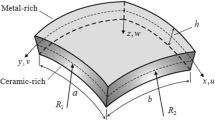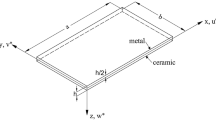Abstract
This paper investigates the application of a double Fourier series technique to the construction of an elastic stress field in a cylindrical bar subject to lateral boundary loads. The lateral loads, including the constant load boundary conditions, are represented by two Fourier series: one on the perimeter of the circular section (r 0, θ) and the other on the longitudinal curved surface parallel to the bar axis (z). The technique invokes acceptable potential functions of the Papkovich–Neuber displacement field, satisfying the governing partial differential equations, to assign appropriate odd and even trigonometric Fourier terms in cylindrical coordinates (r, θ, z). The generic solution decomposes the problem of interest to a state of stress caused by two independent boundary conditions along the z axis and θ-polar angle, both superimposed on a solution for which these potentials are the product of the trigonometric terms of the independent variables (θ, z). Constants appearing in the resultant second-order partial differential equations are determined from the generally mixed (tractions and/or displacements) boundary conditions. While the solutions are satisfied exactly at the ends of an infinite bar, they are satisfied weakly on average, in the light of Saint Venant’s approximation at the two ends of a finite bar. The application of the proposed analysis is verified against available elastic solutions for axisymmetric and non-axisymmetric engineering problems such as the indirect Brazilian Tensile Strength and Point Load Strength tests.











Similar content being viewed by others
Abbreviations
- L, r 0, D :
-
Half the length (width), radius and diameter of a laterally loaded cylinder, respectively
- E, ν :
-
Elastic Young’s modulus and Poisson’s ratio of the material
- e ijk :
-
The permutation or Levi-Civita symbol
- r, θ, z :
-
Polar coordinates with origin at the centre of a laterally loaded cylinder
- x, y, z :
-
Cartesian coordinates with origin at the centre of a laterally loaded cylinder
- \({\varvec{\epsilon}}\) :
-
Strain tensor
- \({\varvec{\sigma}}\) :
-
Stress tensor
- \(\user2 u\) :
-
Displacement vector
- μ, λ :
-
Lamé’s constants
- u, v, w :
-
Components of displacement vector
- \(\bar{{\mathbf I}}\) :
-
Identity matrix
- tr():
-
Trace of a given matrix
- \({\left(\right)}^{\rm T}\) :
-
Transpose of a given matrix
- (),j :
-
The comma in a subscript denotes the derivative symbol, i.e. \(( )_{,j} =\frac{\partial ( )}{\partial x_{j} }\)
- \(\user2{F}\) :
-
Body force vector
- x i :
-
Coordinate directions
- δ ij :
-
The Kronecker delta
- π :
-
The ratio of circle’s perimeter over its diameter
- σ rr , σ θθ , σ zz :
-
Radial, transverse and axial stress components in cylindrical coordinates
- σ r θ , σ θ z , σ rz :
-
Shear stress components in cylindrical coordinates
- σ xx , σ yy , σ xy :
-
Components of stress tensor in Cartesian coordinates
- ∇, ∇., ∇× :
-
Gradient, divergence and curl operators, respectively
- ∇2 :
-
Laplace operator
- \({\varvec{\psi}}\) :
-
Harmonic vector potential
- ϕ :
-
Harmonic scalar potential
- R :
-
The position vector
- ψ r , ψ θ , ψ z :
-
Components of a harmonic vector in cylindrical coordinates
- \(\beta, \gamma, \zeta \) :
-
Frequencies of the lateral load in axial direction of a cylinder
- η :
-
A constant equals or greater than 4
- f :
-
Either the stress or displacement distributions at the surface of a cylinder, i. e. \(u_{r(r=r_{0} )} \) or \(\sigma _{rr(r=r_{0} )}\)
- \(I_{m} (\zeta _{n} r)\) :
-
The modified Bessel function of the first kind of order m and the non-negative argument \(\zeta _{n} r\)
- m, n :
-
Integer numbers
- P :
-
Total load per radial length applied on the lateral curved surface of a cylinder
- S :
-
Total load applied on the lateral curved surface of a cylinder
- p :
-
The applied radial surface stress in Brazilian problem
- p′, q′:
-
The interior and exterior radial stresses in the 2D circular hollow disc of the Lamé problem
- a′, b′:
-
The inner and outer radii in the 2D circular hollow disc of the Lamé problem
- f(n, r), g(n, r), h(n, r):
-
Functions of n and r only in cylindrical coordinates
- f(m, n, r), g(m, n, r), h(m, n, r):
-
Functions of m, n and r only in cylindrical coordinates
- b :
-
Half the width of the applied pressure in the strip loaded problem and also in the point load test
- α :
-
Half the loading angle in both Brazilian and point load problems
- t :
-
The thickness of the Brazilian disc
References
Airy GB (1862) British Association Adv. Sci. Dept. and Philosophical Transaction of the Royal Society of London, vol 153, p 49
Alehossein H, Serati M (2013) 3D Fourier–Papkovich–Neuber elastic analysis in prolate spheroidal coordinates (submitted)
Arfken GB, Weber HJ, Harris FE (2011) Mathematical methods for physicists: a comprehensive guide, 7th edn. Elsevier Science, MA
ASTM (2008a) D3967-08: standard test method for splitting tensile strength of intact rock core specimens. ASTM International, West Conshohocken
ASTM (2008b) D5731-08: standard test method for determination of the Point Load Strength Index of rock and application to rock strength classifications. ASTM International, West Conshohocken
Barber JR (2006a) Three-dimensional elasticity problems for the prismatic bar. In: Proceedings of the royal society A: mathematical, physical and engineering science, pp 834–841
Barber JR (2006b) Three-dimensional elasticity solutions for isotropic and generally anisotropic bodies. Appl Mech Mater 5:541–550
Barber JR (2010) Elasticity. Springer, Berlin
Barton MV (1941) The circular cylinder with a band of uniform pressure on a finite length of the surface. J Appl Mech 8:97–104
Chau KT (1998) Analytic solutions for diametral point load strength tests. J Eng Mech 124(8):875–883
Chau KT, Wei XX (2000) Finite solid circular cylinders subjected to arbitrary surface load. Part I—analytic solution. Int J Solids Struct 37(40):5707–5732
Chau KT, Wei XX (2001) A new analytic solution for the diametral point load strength test on finite solid circular cylinders. Int J Solids Struct 38(9):1459–1481
Chiu YP, Weinstein AS, Zorowski CF (1964) Elastic behaviour of a cylinder subjected to a biaxially symmetric normal surface loading. Q J Mech Appl Math 17(2):199–215
Diyuan L, Louis NYW (2012) The Brazilian disc test for rock mechanics applications: review and new insights. In: Rock mechanics and rock engineering, pp 1–19
Eubanks RA, Sternberg E (1956) On the completeness of the Boussinesq–Papkovich stress functions. J Ration Mech Anal 5(1):735–746
Franklin JA (1985) Suggested method for determining point load strength. Int J Rock Mech Min Sci Geomech Abstr 22(2):51–60
Gurtin ME (1962) On Helmholtz’s theorem and the completeness of the Papkovich–Neuber stress functions for infinite domains. Arch Ration Mech Anal 9(1):225–233
Hiramatsu Y, Oka Y (1966) Determination of the tensile strength of rock by a compression test of an irregular test piece. Int J Rock Mech Min Sci Geomech Abstr 3(2):89–90
Hondros G (1959) The evaluation of Poisson’s ratio and the modulus of materials of a low tensile resistance by the Brazilian (indirect tensile) test with particular reference to concrete. Aust J Appl Sci 10:243–268
ISRM (1978) Suggested methods for determining tensile strength of rock materials. Int J Rock Mech Min Sci Geomech Abstr 15(3):99–103
ISRM (1985) Suggested method for determining point load strength. Int J Rock Mech Min Sci Geomech Abstr 22:51–60
Klosner JM (1962) The elasticity solution of a long circular-cylindrical shell subjected to a uniform, circumferential, radial line load. J Aerosp Sci, pp 834–841
Little RW (1973) Elasticity. In: Civil engineering and engineering mechanics series. Prentice Hall, Englewood Cliffs
Lurie AI, Belyaev A (2005) Theory of Elasticity. Foundations of Engineering Mechanics. Springer, Berlin. http://link.springer.com/book/10.1007/978-3-540-26455-2/page/1
Markides C, Kourkoulis S (2012) The stress field in a standardized Brazilian disc: the influence of the loading type acting on the actual contact length. Rock Mech Rock Eng 45(2):145–158
Moon P, Spencer DE (1953) The meaning of the vector laplacian. J Frankl Inst 256(6):551–558
Moon P, Spencer DE (1988) Field theory handbook, including coordinate systems, differential equations, and their solutions, 2nd edn. Springer, New York
Piltner R (1989) On the representation of three-dimensional elasticity solutions with the aid of complex valued functions. J Elast 22(1):45–55
Sadd MH (2009) Elasticity: theory, applications, and numerics, 2nd edn. Elsevier, Academic Press
Serati M, Alehossein H, Williams DJ (2012) Elastic stress analysis of partially loaded hollow discs. Int J Eng Sci 53(0):19–37
Shima H, Nakayama T (2010) Higher mathematics for physics and engineering, 7th edn. Springer, Berlin
Simmonds JG (1994) A brief on tensor analysis, 2nd edn. Springer, New York
Sokolnikoff IS (1946) Mathematical theory of elasticity, 1st edn. McGraw-Hill, New York
Steven GP (1977) A non-axisymmetric cylindrical contact problem. Int J Eng Sci 15(2):95–103
Timoshenko SP, Goodier JN (1969) Theory of elasticity, 3rd edn. McGraw-Hill, New York
Ugural A, Fenster S (2003) Advanced strength and applied elasticity, 4th edn. Prentice Hall PTR, Upper Saddle River
Wang MZ (1988) Brebbia’s indirect representation and the completeness of Papkovich–Neuber’s and Boussinesq-Galerkin’s solutions in elasticity. Appl Math Model 12(3):333–335
Watanabe S (1996) Elastic analysis of axi-symmetric finite cylinder constrained radial displacement on the loading end. Struct Eng Earthq Eng JSCE 13(2):175s–186s
Wijk G (1978) Some new theoretical aspects of indirect measurements of the tensile strength of rocks. Int J Rock Mech Min Sci Geomech Abstr 15(4):149–160
Yanagidani T, Sano O, Terada M, Ito I (1978) The observation of cracks propagating in diametrically-compressed rock discs. Int J Rock Mech Min Sci Geomech Abstr 15(5):225–235
Yao JC (1969) Long cylindrical tube subjected to two diametrically opposite loads (stress concentration in long thick cylindrical tube under diametrically opposite normal loads using elasticity theory). Aeronaut Q 20:365–381
Youngdahl CK (1969) On the completeness of a set of stress functions appropriate to the solution of elasticity problems in general cylindrical coordinates. Int J Eng Sci 7(1):61–79
Acknowledgments
The first author acknowledges two scholarships, granted by the Commonwealth Scientific and Industrial Research Organization (CSIRO) and The University of Queensland (UQ): (i) Minerals Down Under Flagship Scholarship of CSIRO (CESRE), and (ii) UQ Postgraduate Scholarship from the School of Civil Engineering at UQ. The authors also acknowledge the valuable discussions with Professor Emmanuel Detournay, of the University of Minnesota, on the subject.
Author information
Authors and Affiliations
Corresponding author
Rights and permissions
About this article
Cite this article
Serati, M., Alehossein, H. & Williams, D.J. 3D Elastic Solutions for Laterally Loaded Discs: Generalised Brazilian and Point Load Tests. Rock Mech Rock Eng 47, 1087–1101 (2014). https://doi.org/10.1007/s00603-013-0449-9
Received:
Accepted:
Published:
Issue Date:
DOI: https://doi.org/10.1007/s00603-013-0449-9




